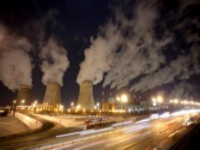Greenhouse Gas Emissions Gap Widening
 Action on climate change needs to be scaled-up and accelerated without delay if the world is to have a running chance of keeping a global average temperature rise below 2 degrees Celsius this century.
Action on climate change needs to be scaled-up and accelerated without delay if the world is to have a running chance of keeping a global average temperature rise below 2 degrees Celsius this century. The Emissions Gap Report, coordinated by the UN Environment Programme (UNEP) and the European Climate Foundation, and released days before the convening of the Climate Change Conference of the Parties in Doha, shows that greenhouse gas emissions levels are now around 14 per cent above where they need to be in 2020.
If no swift action is taken by nations, emissions are likely to be at 58 gigatonnes (Gt) in eight years’ time, says the report which has involved 55 scientists from more than 20 countries.
This will leave a gap that is now bigger than it was in earlier UNEP assessments of 2010 and 2011 and is in part as a result of projected economic growth in key developing economies and a phenomenon known as ‘double counting’ of emission offsets.
Previous assessment reports have underlined that emissions need to be on average at around 44 Gt or less in 2020 to lay the path for the even bigger reductions needed at a cost that is manageable.
The Emissions Gap Report 2012 points out that even if the most ambitious level of pledges and commitments were implemented by all countries-and under the strictest set of rules-there will now be a gap of 8 Gt of CO2 equivalent by 2020.
This is 2 Gt higher than last year’s assessment with yet another year passing by.
Preliminary economic assessments, highlighted in the new report, estimate that inaction will trigger costs likely to be at least 10 to 15 per cent higher after 2020 if the needed emission reductions are delayed into the following decades.
 Achim Steiner (pictured left), UN Under-Secretary General and UNEP Executive Director, said: “There are two realities encapsulated in this report-that bridging the gap remains do-able with existing technologies and policies; that there are many inspiring actions taking place at the national level on energy efficiency in buildings, investing in forests to avoid emissions linked with deforestation and new vehicle emissions standards alongside a remarkable growth in investment in new renewable energies worldwide, which in 2011 totaled close to US$260 billion”.
Achim Steiner (pictured left), UN Under-Secretary General and UNEP Executive Director, said: “There are two realities encapsulated in this report-that bridging the gap remains do-able with existing technologies and policies; that there are many inspiring actions taking place at the national level on energy efficiency in buildings, investing in forests to avoid emissions linked with deforestation and new vehicle emissions standards alongside a remarkable growth in investment in new renewable energies worldwide, which in 2011 totaled close to US$260 billion”.“Yet the sobering fact remains that a transition to a low carbon, inclusive Green Economy is happening far too slowly and the opportunity for meeting the 44 Gt target is narrowing annually,” he added.
“While governments work to negotiate a new international climate agreement to come into effect in 2020, they urgently need to put their foot firmly on the action pedal by fulfilling financial, technology transfer and other commitments under the UN climate convention treaties. There are also a wide range of complementary voluntary measures that can that can bridge the gap between ambition and reality now rather than later,” said Mr. Steiner.
The report estimates that there are potentially large emissions reductions possible-in a mid-range of 17 Gt of CO2 equivalents-from sectors such as buildings, power generation and transport that can more than bridge the gap by 2020.
Meanwhile, there are abundant examples of actions at the national level in areas ranging from improved building codes to fuel standards for vehicles which, if scaled up and replicated, can also assist.
 Christiana Figueres (pictured right), Executive Secretary of the UN Framework Convention on Climate Change, said, “This report is a reminder that time is running out, but that the technical means and the policy tools to allow the world to stay below a maximum 2 degrees Celsius are still available to governments and societies”.
Christiana Figueres (pictured right), Executive Secretary of the UN Framework Convention on Climate Change, said, “This report is a reminder that time is running out, but that the technical means and the policy tools to allow the world to stay below a maximum 2 degrees Celsius are still available to governments and societies”.“Governments meeting in Doha for COP18 now need to urgently implement existing decisions which will allow for a swifter transition towards a low-carbon and resilient world. This notably means amending the Kyoto Protocol, developing a clear vision of how greenhouse gases can be curbed globally before and after 2020, and completing the institutions required to help developing countries green their economies and adapt, along with defining how the long-term climate finance that developing countries need can be mobilized. In addition, governments need to urgently identify how ambition can be raised, “added Ms. Figueres.
Bridging the Gap
The report looked at sectors where the necessary emissions reductions may be possible by 2020.
Improved energy efficiency in industry could deliver cuts of between 1.5 to 4.6 Gt of CO2 equivalent; followed by agriculture, 1.1 to 4.3 Gt; forestry 1.3 to 4.2 Gt; the power sector, 2.2 to 3.9 Gt; buildings 1.4 to 2.9 Gt; transportation including shipping and aviation 1.7 to 2.5 Gt and the waste sector around 0.8 Gt.
Buildings - The report points out that some sectors have even bigger potential over the long term-boosting the energy efficiency of buildings, for example, could deliver average reductions of around 2.1 Gt by 2020 but cuts of over 9Gt CO2 equivalent by 2050.
“This implies that by 2050 the building sector could consume 30 per cent less electricity compared to 2005 despite a close to 130 per cent projected increase in built floor area over the same period,” it says.
The report concludes that if this is to happen, “state of the art building codes may need to become mandatory in the next 10 years in all of the major economies such as the United States, India, China and the European Union”.
Further emission reductions are possible from more energy efficient appliances and lighting systems. The report cites Japan’s Top Runner Programme and the Ecodesign Directive of the European Union which have triggered household electricity consumption savings of 11 per cent and 16 per cent respectively.
It also cites Ghana’s standards and labelling programme for air conditioners which is set to save consumers and businesses an estimated US$64 million annually in reduced energy bills and around 2.8 million tonnes of CO2 equivalent over 30 years.
Sustainable Transportation - Potential emissions reductions from the transportation sector are assessed at 2 Gt of CO2 equivalent by 2020.
The report notes that there is already a shift with the eight biggest multilateral development banks at the recent Rio+20 Summit pledging US$175 billion over the next decade for measures such as bus rapid transport systems.
The report recommends the “Avoid, Shift and Improve’ polices and measures that encourage improved land planning and alternative mobility options such as buses, cycling and walking above the private car alongside better use of rail freight and inland waterways.
Combinations of improved vehicle standards and scrappage schemes for old vehicles can also assist. The report says approved and proposed new standards in seven countries ranging from Australia and China to the European Union, the Republic of Korea and the United States are expected to reduce fuel consumption and greenhouse gas emissions of new light-duty vehicles by over 50 per cent by 2025 from 2000 levels.
Forestry - “Although it remained under-utilized, “avoided deforestation” is considered a low cost greenhouse gas emissions reductions option,” says the report.
Policies to assist in reducing deforestation and, thus, greenhouse gas emissions, include establishing protected areas such as national parks to economic instruments such as taxes, subsidies and payments for ecosystem services.
The report cites Brazil where a combination of conservation policies allied to falls in agricultural commodity prices has led to a decrease in deforestation by three quarters since 2004 avoiding 2.8 Gt of CO2 equivalent between 2006 and 2011.
Protected areas in Costa Rica now represent over as fifth of its territory, reducing greenhouse gas emissions and triggering a rise in tourists from just under 390,000 in 1988 to 2.5 million in 2008: tourism now accounts for around 15 per cent of GDP.
These actions by Brazil and Costa Rica predate Reduced Emissions from Deforestation and forest Degradation (REDD or REDD+) policies under the UN Convention for Combating Climate Change.
The report indicates that scaled-up action under, for example, the UN-REDD initiative which is working with over 40 countries, can provide even larger emission reductions while generating additional benefits such as jobs in natural resource management.
You can return to the main Market News page, or press the Back button on your browser.

